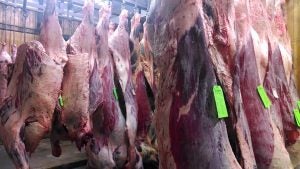I had the most fascinating experience the other day! I wanted to learn more about how thoroughly meat is inspected so I took some time to interact with a food safety inspector and ask questions. We were taking some livestock in for our customers and much to my surprise, I got to watch them butcher and inspect the cattle! Boy is it in-depth and interesting.
First off, the inspector wears the cleanest, whitest pants you could imagine. A clean, white hard had and hair net. From a first impression standpoint, it shows a level of cleanliness and pride. (He obviously wears an apron during the inspection part.) All the equipment is inspected and knives and such are repeatedly sanitized throughout the process.
It is crazy awesome to learn that every animal we eat that goes to the public in a grocery store or restaurant is inspected. Every. One. They check the animal before it is butchered to make sure it isn’t showing signs of illness, has perky ears, and healthy looking eyes. They check all eight glands in the head, behind the ears, the tonsils, the tongue, etc.
Then he checked the organs: heart, liver, lungs, and gall bladder, among others. The butcher is looking for anything on the carcass as well. They were kind, patient, and answered all of my questions. The inspector was at Texas A&M for a training program to do this. I got an extensive biology lesson and even got to hold some organs! I thought I’d be grossed out but actually found it quite cool.
They are careful when doing the cuts to prevent E. coli. If even a dot of manure or dirt ends up on the carcass from the hide or whatnot, the entire part of the meat is cut off and discarded. It is cleaned and hung and sprayed with a water/vinegar solution on the outside to kill any bacteria. Although this vinegar mixture would be safe for us to eat, most of that part will be cut off during the packaging process since a lot of it is just fat. This photo shows the hanging process before it’s all packaged and cut. There’s a stamp of approval on it with edible ink, followed by tracking and a ton of paperwork. Both the butcher and the inspector said it is rare they receive a sick animal for inspection (which wouldn’t be approved), and that means farmers are doing a very good job!

I wasn’t sure what to expect in all this. I was a little worried it would turn me off and I might not want to eat beef for a while, but actually just the opposite happened! Once I learned more about just how in-depth and thorough our nation’s inspection process is, I am that much more comfortable with raising and eating meat. We have some of the safest, most abundant food in the world — it’s a system to be envied. You could hear the inspector speak with pride at how humane our system is. We had a great conversation about how, in our opinion, it is right to eat animals but that we owe them a level of respect. I’m so proud to be a cattle and lamb farmer and am honored to deliver this safe, healthy, and nutritious food product from our family to yours.
Sometimes we hear that food companies should be more transparent. That may be true, but if you really want to know, just ask! Find a farmer. Visit a food-production plant near you. Ask your butcher at the meat counter questions and listen to what they have to say. You might learn something. I always say, “The right to know requires the responsibility to learn.” It doesn’t hurt to ask.
For more info, the federal Food Safety and Inspection Service does have a consumer education blog you can read here.
Enjoy your thoroughly inspected meat, milk, and eggs!
Did you like what you read? Sign up here in a heartbeat to get the best from AGDAILY.com!



